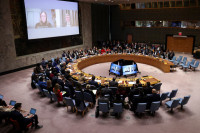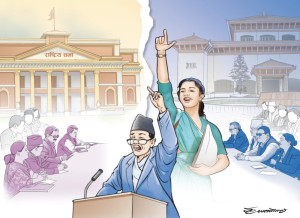Columns
Himalayan power caravan
If Nepal wants to play in the Indian power market, it should be present in that market.
Bishal Thapa
Nepal’s strategy for trading power with India is highly reminiscent of Eric Valli’s beautiful film Himalaya, which opened in Nepal as Caravan. Released in 1999, the movie went on to secure a nomination for Best Foreign Film at the Academy Awards (Oscars), in addition to several other accolades. Set against the exquisite backdrop of the mountainous Dolpo region, the film tells the story of villagers leading a yak caravan carrying rock salt to trade for grain in the plains. The idea of hardy, handsome, spiritually enlightened men descending steep mountains and navigating treacherous terrains and ferocious weather to trade their produce might make for a great movie plot worthy of an Oscar, but makes for one lousy strategy for trading electricity.
Instead of shepherding a caravan through treacherous rocky ravines every wet season, Nepal must find the courage to come down from the hill posts in the mountains, set up shop in India and trade its electricity. If we believe in the potential of the Indian power markets, then in India’s marketplace we must be.
Elusive India market
The recently concluded Nepal Power Summit 2023 was repeatedly punctuated, on one side, with a sense of urgency about the looming surplus in Nepal’s electricity generation, and, on the other side, about India’s intransigence at agreeing to let Nepal’s power through. Nepal currently has approval to sell electricity from 10 hydropower plants totalling 453 megawatts. It is already seeking approval to sell 1,000 megawatts, Prabal Adhikari, director of power trade at the Nepal Electricity Authority (NEA) said in a statement to The Kathmandu Post last month. That 1,000 megawatts is only for now.
NEA Managing Director Kulman Ghising projects that the country will add on average 800 megawatts annually, reaching an estimated 7,000 megawatts in the next five years. Much of the generation from these plants will need to be exported, as domestic demand is unlikely to increase significantly to absorb the growth. Nepal is seeking “unrestricted market access”. So far, India appears to have offered “adequate market access”. The fate of many Nepali hydropower plants appears to be hanging on the distinction between “unrestricted” and “adequate”.
Nepal is also seeking sustained, long-term access and has requested for a 25-year agreement for its power exports. Much in the same way, perhaps, that India secured long-term access for its exports to Nepal. The Dhalkebar-Muzaffarpur cross-border transmission line that is now seen as a potential gateway for Nepal’s power exports to India was financed, in part, through a long-term power sale agreement where the NEA agreed to import 150 megawatts power from Power Trading Corporation—India for 25 years.
Nepal is seeking to discuss several of these vexing issues that hobble Nepal-India power trade during the prime minister’s forthcoming visit to India. But these discussions can only happen if the other side agrees to discuss them in the first place. This sense of paralysis may have led Ashish Garg, vice-chairperson of the Independent Power Producers’ Association Nepal (IPPAN), to lament in a statement to The Kathmandu Post on April 18, 2023 that “Nepal’s power sector has been dragged into geopolitics, which we don’t want.”
Finding markets
To overcome the impasse on power trade, Nepal might benefit from reconsidering its negotiating position. Nepal is seeking not only a 25-year agreement, but also a 25-year inter-governmental agreement. One of its favourite strategies is to seek “government-to-government” agreements in the hope that such an arrangement will avoid the hassle of periodic approvals or other bureaucratic hurdles.
The Indian government is no doubt a powerful force in India’s power market. It sets the rules, routinely provides detailed direction and steers the market through several state-owned enterprises. The Indian power sector remains a managed market. Yet, it is also a sector that has evolved. Reforms, and structural changes over the last two decades have systematically, and intentionally, reduced and marginalised the influence of government or political direction. The regulatory agencies that govern the sector are stronger and mature, though not uniformly across the states.
The marketplace is deeper with many different players. Even state-owned enterprises in the sector behave as independent corporate entities. Because most of them are publicly listed, they abide by securities exchange rules that require higher levels of corporate governance, and independent boards. The Indian power market is governed more by its rules than by the day-to-day influences of government.
Nepal may feel that the distress with its surplus generation is adding up fast. But, perhaps, it ought to consider that the Indian government’s ability to resolve that distress by itself may be more limited than Nepal believes. Until a few years ago, for example, non-performing power generation assets had breached over approximately $17 billion, sending shivers through the entire banking system. A few years hence, the situation is vastly improved. But the distress still lingers.
The Indian Ministry of Power’s year-end review in 2021, for instance, listed 10 projects totalling 10,530 megawatts that were already stalled at early stages of construction and were ordered to go into liquidation. Another seven projects of 9,310 megawatts were still going through the debt resolution process, while 17 projects totalling 20,290 megawatts had recently completed the process. Maybe governments can do magic–and they often do–but in many instances, as in the Indian power sector, governments let markets work out the wrinkles.
Nepal is also hamstrung in its negotiations with India on power trade because it has no market of its own. It has also made no real meaningful reform efforts to create a market. It is hard to seek unrestricted access connecting markets when you have no market of your own to offer. Nepal must consider revising its approaches.
One, set up an energy firm in India that covers electricity and liquid fuels and serves as a conduit for aggregating investments into Nepal’s energy sector. The firm will be governed and protected by Indian laws and market rules, and may be more successful in securing long-term access and investment inflows. It could also use the full range of capabilities in Indian markets, including, for example, its capital markets for currency hedging, or structuring long-term power offtake.
Second, reform Nepal’s domestic power sector.
Neither of these measures will offer immediate relief for the 1,000 megawatts that the NEA is seeking to sell now. For that, perhaps high-level political intervention, and the usual give-and-take of geopolitics may be the only answer. But for the longer term, Nepal needs a fresh outlook that looks to engage not just with the government of India, but also with the actual power markets of India.
Watch Valli’s film, Himalaya/Caravan, again. Listen carefully when one of the lead characters is asked why he came with the caravan. Because, he says, “When two paths open up before you, always choose the hardest one.” Our Himalayan spirituality that encourages us to take the harder path has always befuddled us. But hard as it may be, a fresh approach to trading power with India may lead to an easier path than leading a caravan down treacherous paths every summer.




 5.81°C Kathmandu
5.81°C Kathmandu















